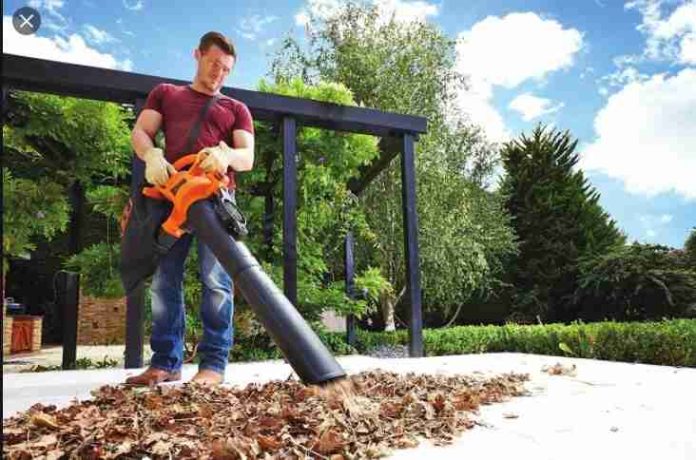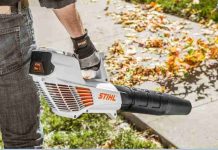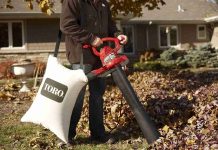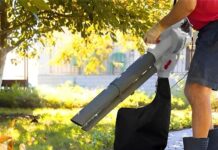When you pick up your new leaf blower, there’s no better feeling than the first time you switch it on and feel the kickback from the power.
It’s one of the most enjoyable yard maintenance tools.
However, when you pick up your leaf blower, the last thing on your mind is usually the day it breaks down.
In this article, we’ll go over how to take care of your leaf blower.
We’ll show you precisely what you need to do to prevent an early breakdown of your leaf blower and how you can make sure it stays in excellent condition for years to come.
General Leaf Blower Maintenance
Different leaf blowers require different levels of maintenance.
However, every leaf blower has a few general maintenance requirements to keep them running smoothly.
Whenever you’re finished using your leaf blower for the day, please take a minute to inspect it and wipe down any components that might accumulate debris or dust like vents, fans, and air filters.
If you spot any dust or dirt covering the outside of your leaf blower, use a bit of soap and water with a cloth and wipe it down.
Don’t use any harsh chemicals that might damage the leaf blower.
Also, check your leaf blower’s trigger or throttle once a week, even if you aren’t using it in the off-season.
Maintaining Your Gas Leaf Blower
Gas-powered leaf blowers provide a ton of extra power, so you’ll need to take extra care of them compared to electric leaf blowers.
Every gas leaf blower will come with a list of components that need to be checked at the beginning of the season.
Here are the standard components that you should remember to check:
First, remove felt or sponge pieces from the filter. You should clean your air filter every 10 hours of using the leaf blower.
Next, soak them in soapy water quickly, rinse them, and let them dry.
Finally, put a couple of drops of oil into the sponge or filter.
If your blower uses a paper filter, gently tap it against a surface to remove any dirt.
It would be best if you replaced it once a year.
Just like cars, gas leaf blowers have spark plugs that need maintenance.
You should regularly disconnect the spark plug and check it for any corrosion once a week while periodically using it.
It would be best if you replaced it every year or every 25 hours of use.
After 30 days, your gas will start to degrade. If left longer, it can damage the fuel lines and gas tank.
Make sure to drain it monthly. For long-term storage, drain the tank, run the engine dry, and ensure it’s empty before putting it away for the off-season.
Always use the right amount of 2-stroke oil with the gas for 2-cycle engines (50:1). Never use motor oil as it could damage the engine.
Read Next – Black Decker Blower Vacuum
Fuel Filter
Your fuel filter sits on the end of the fuel line that goes into your fuel tank.
First, disconnect the spark plug, and use a small hook to take the filter out. Put a new filter in once per year.
2-cycle leaf blowers use a gas and oil mix, but 4-cycle leaf blowers will have separate oil and gas tanks.
Do your first oil change on a 4-cycle leaf blower after the early 20 hours of use.
Then, begin changing it every 50 hours after that.
If your carburetor becomes clogged, it can stop your engine from starting or prevent it from firing.
Remove the external panel and do a few quick sprays of carb cleaner inside the choke.
It would be best if you cleaned the carburetor once per year.
Read Next – Cordless Leaf Blower KIMO 20 Sweeper
Spark Arrestor
Leaf blowers with catalytic converters to reduce emissions also feature a spark arrestor on the muffler.
You must remove the screen from the exhaust pipe and clean it with a brush monthly.
Some gas leaf blowers will have a built-in vacuum.
If yours does, take the vacuum bag out and clean it once per year.
Read Next – Top 5 Best Handheld Leaf Blower Reviews of 2021
Maintaining Your Electric Leaf Blower

Electric leaf blowers aren’t as demanding maintenance-wise as gas leaf blowers.
However, they still require ongoing care if you want to ensure they run well for years.
If your leaf blower is battery operated, remember to inspect the battery before every use.
Check for leaks and check the charge level.
If your battery is fully charged, don’t leave it in the charger or the leaf blower when you’re not using it, as it will drain the battery.
At the beginning of the season, clean your leaf blower’s battery contacts by wiping them with a dry cloth.
You should do this once per month in-season as well.
If you have a corded leaf blower, always check the cord and the connection point before you plug it in.
If the wire is frayed or there’s a missing grounding pin on the plug, it could cause an electric shock that could damage the cord or, worse yet, gives you a harmful surprise.
Read Next – Top 5 Most Powerful Handheld Leaf Blower Reviews 2022
BLACK+DECKER Electric Leaf Blower, 7-Amp (LB700)
4 used from $21.99
Sun Joe SBJ597E-SJB 6-Amp 155 MPH Electric Leaf Blower, Blue
$32.97 in stock
1 used from $29.92
WORX WG520 Turbine 600 Corded Electric Leaf Blower, Black
$69.99 in stock
5 used from $61.00
Greenworks 24012 7 Amp Single Speed Electric 160 MPH Blower
$45.34 in stock
Toro 51585 Power Sweep Electric Leaf Blower, 7 Amp 2-Speed
Cordless Leaf Blower - Electric Leaf Blower battery-powered, 20V Lithium Leaf Blower Cordless with Battery & Charger, Powerful Cordless Blower Lightweight for Sweeping Snow (Battery&Charger Included)
BLACK+DECKER 3-in-1 Electric Leaf Blower & Mulcher with Leaf Vacuum Kit, 12-Amp (BV6000)
5 used from $71.18
Toro 51621 UltraPlus Leaf Blower Vacuum, Variable-Speed (up to 250 mph) with Metal Impeller, 12 amp,Red
5 used from $107.26
BLACK+DECKER 3-in-1 Electric Leaf Blower, Leaf Vacuum, Mulcher, 12-Amp (BV3600)
5 used from $45.99
BLACK+DECKER Leaf Blower, Axial, 9-Amp (BEBL750)
3 used from $39.99
WORX WG545.6 20V 2.0Ah Cordless AIR Leaf Blower Battery and Charger Included
CRAFTSMAN Leaf Blower, Electric, 12-Amp (CMEBL700)
4 used from $85.80















































